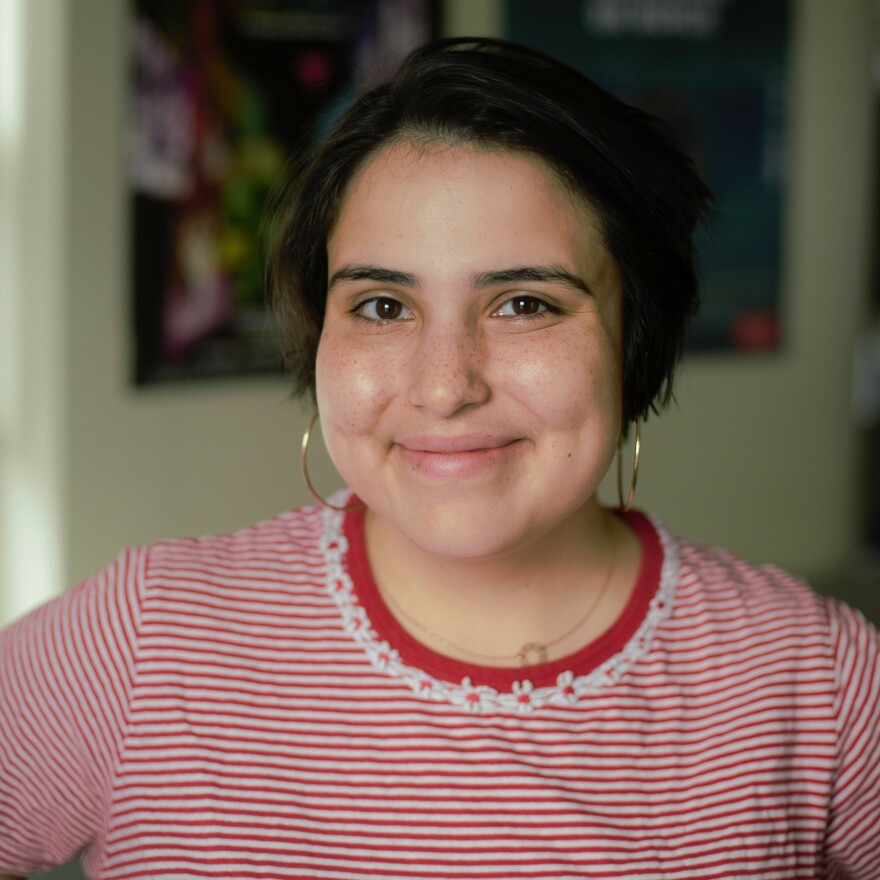It's a tale as old as 2020: One day, I was in the NPR office making after-work plans with friends; the next, I was taking my laptop home to work remotely for "just a few weeks."
A few weeks later, I had tried all the early-pandemic activities I could think of — sourdough starter, anyone? — and as the months passed, I grew sick of Zoom happy hours and TV marathons, and started searching anew for something — anything — to fill the ever-expanding days.

Then, one day during my daily scroll, a headline on a shopping website stopped me in my tracks: "This Weaving Loom Saved Me When All My (Pre-Pandemic) Hobbies Disappeared."
This was the universe speaking to me. I, too, was in desperate need of a hobby appropriate for the homebound. In a moment of pure impulsivity, I bought all the things the writer recommended — a small but sturdy loom that could fit in my lap, warp string, a few colors of yarn, a book full of weaving tutorials.
Looms are typically large wood contraptions strung with thread (warp), through which other, colorful threads (weft) are passed through. They can be as simple as a backstrap loom, which can consist of just two sticks with warp strung between them. Or complex, like treadle looms that involve multiple beams, rods and foot pedals to lift and lower the warp threads.
I was introduced to weaving through backstrap looms often used by Indigenous women in Central America, where my extended family lives. For these artisans, weaving is both an art form and a way to make the stuff of everyday life, as well as a way to keep old traditions alive. For me, weaving has been a way to pass the time — with a simple frame loom, my work consists mostly of tapestries that could become wall hangings or decorative pillows.
My first weaving looked ... not great. I decided to skip the tutorials in the book and freestyle a pink-and-white tapestry to hang on my apartment door for Valentine's Day. It started off OK; I strung the loom successfully and figured out how to glide the yarn-threaded needle over and under the warp thread.

Then, mistake after mistake: I pulled the yarn way too tight, making the sides curve in. There were lots of gaps, where you could see the white warp thread peeking out from underneath the colored yarn. And when I reached the bottom of the loom, I couldn't figure out how to make the long fringe that I saw on other tapestries — and, in a fit of frustration, left the bottom a scraggly mess.
But, as the cliche goes, practice made perfect. Humbled by my hubris, I cracked open the weaving book and tried some basic patterns, using the simplest stitches: blocks of plain tabby weave, thin pick-and-pick rows, thick soumak braids. I learned how to get my edges straight and my ends less unkempt. And I started to make tapestries I actually liked, that I wanted to hang on my wall. I even figured out how to sew backs onto them, stuff them with polyester fiber and make colorful pillows to display on my couch.
I was officially hooked; I spent my free time weaving while listening to podcasts and audiobooks. Soon I realized that there are only so many tapestries you can make and hang in your apartment, or pillows you can arrange on your chairs. I started making them for friends, then making commissioned pieces for others, who gave me a color palette and left the rest to me.
I wove rows of rainbows, Mondrian-esque blocks of primary colors, and ocean waves of every shade of blue I could get my hands on. I even saved up money to buy a 4-by-4-foot loom, where I sit and work on even bigger tapestries.
Months and months later, I've accumulated enough weaving supplies – wool roving, cotton thread, silky ribbons — to fill two craft carts. What started off as an impulse-driven hobby has turned into the closest thing to an artistic practice that I've ever had. I've never been particularly good at painting, drawing or anything else that requires hand-eye-brain coordination. But weaving, somehow, feels different.
Every time I pick up my loom, my brain quiets down; as my needle slips between warp threads, my cortisol levels plunge. I've never loved a hobby quite like this.
The meditative quality is probably why I've stuck with it. Back when I ordered my first loom, I was an anxious wreck, ruminating endlessly about COVID case counts and droplets and when I'd next be able to travel to see my loved ones.
My therapist, who'd once observed that my hands get fidgety when I'm anxious, recommended that I keep them busy to keep the nerves at bay. And since then, weaving has become a way to ground myself — in the tangibility of yarn and thread and stitching — and to make something beautiful at the same time.
What are you really into? Fill out this form or leave us a voice note at 1-800-329-4273, and part of your submission may be featured online or on the radio.
Copyright 2023 NPR. To see more, visit https://www.npr.org.




